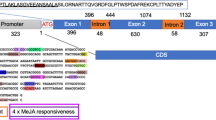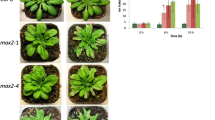Abstract
The symptoms of the clubroot disease on Brassica species caused by the obligate biotrophic protist Plasmodiophora brassicae relies, among other factors, on the modulation of plant hormones. Signaling, transport as well as biosynthesis and metabolism are key features how the levels of auxins and cytokinins are controlled. We here describe (a) how to inoculate the model plant Arabidopsis thaliana with P. brassicae, (b) qualitative and quantitative methods to evaluate disease severity in auxin and cytokinin mutants, (c) molecular methods to monitor changes in plant and pathogen transcripts, (d) prerequisites for the establishment of transgenic lines manipulated in an auxin or cytokinin pathway, and (e) methods for β-glucuronidase staining in root galls and sections of infected roots to determine auxin and cytokinin responsive promoter activities.
Susann Auer, Sabine Jülke, and Sabine Marschollek in alphabetical order.
Access this chapter
Tax calculation will be finalised at checkout
Purchases are for personal use only
Similar content being viewed by others
References
Siemens J, Nagel M, Ludwig-Müller J, Sacristán MD (2002) The interaction of Plasmodiophora brassicae and Arabidopsis thaliana: parameters for disease quantification and screening of mutant lines. J Phytopathol 150:592–605
Kageyama K, Asano T (2009) Life cycle of Plasmodiophora brassicae. J Plant Growth Regul 28:203–211
Jahn L, Mucha S, Bergmann S, Horn C, Siemens J, Staswick P, Steffens B, Ludwig-Müller J (2013) The clubroot pathogen (Plasmodiophora brassicae) influences auxin signaling to regulate auxin homeostasis. Plants 2:726–749
Siemens J, Keller I, Sarx J, Kunz S, Schuller A, Nagel W, Schmülling T, Parniske M, Ludwig-Müller J (2006) Transcriptome analysis of Arabidopsis clubroots indicate a key role for cytokinins in disease development. Mol Plant Microbe Interact 19:480–494
Schuller A, Kehr J, Ludwig-Müller J (2014) Laser microdissection coupled to transcriptional profiling of Arabidopsis roots inoculated by Plasmodiophora brassicae indicates a role for brassinosteroids in clubroot formation. Plant Cell Physiol 55:392–411
Grsic-Rausch S, Kobelt P, Siemens J, Bischoff M, Ludwig-Müller J (2000) Expression and localization of nitrilase during symptom development of the clubroot disease in Arabidopsis thaliana. Plant Physiol 122:369–378
Päsold S, Siegel I, Seidel C, Ludwig-Müller J (2010) Flavonoid accumulation in Arabidopsis thaliana root galls caused by the obligate biotrophic pathogen Plasmodiophora brassicae. Mol Plant Pathol 11:545–562
Devos S, Laukens K, Deckers P, Van Der Straeten D, Beeckman T, Inzé D, Van Onckelen H, Witters E, Prinsen E (2006) A hormone and proteome approach to picturing the initial metabolic events during Plasmodiophora brassicae infection on Arabidopsis. Mol Plant Microbe Interact 19:1431–1443
Malinowski R, Smith JA, Fleming AJ, Scholes JD, Rolfe SA (2012) Gall formation in clubroot-infected Arabidopsis results from an increase in existing meristematic activities of the host but is not essential for the completion of the pathogen life cycle. Plant J 71:226–238
Knaust A, Ludwig-Müller J (2013) The ethylene signaling pathway is needed to restrict root gall growth in Arabidopsis after infection with the obligate biotrophic protist Plasmodiophora brassicae. J Plant Growth Regul 32:9–21
Siemens J, Gonzales M-C, Wolf S, Hofmann C, Greiner S, Du Y, Rausch T, Roitsch T, Ludwig-Müller J (2011) Extracellular invertase is involved in the regulation of the clubroot disease in Arabidopsis thaliana. Mol Plant Pathol 12:247–262
Faggian R, Strelkov SE (2009) Detection and measurement of Plasmodiophora brassicae. J Plant Growth Regul 28:282–288
Schwelm A, Fogelqvist J, Knaust A, Jülke S, Lilja T, Bonilla-Rosso G, Karlsson M, Shevchenko A, Choi SR, Dhandapani V, Kim HG, Park JY, Lim YP, Ludwig-Müller J, Dixelius C (2015) The Plasmodiophora brassicae genome reveals insights in its life cycle and ancestry of chitin synthases. Sci Rep 5:11153. doi:10.1038/srep11153
Staswick PE, Serban B, Rowe M, Tiryaki I, Maldonado MT, Maldonado MC, Suza W (2005) Characterization of an Arabidopsis enzyme family that conjugates amino acids to indole-3-acetic acid. Plant Cell 17:616–627
Feng J, Hwang SF, Strelkov SE (2013) Genetic transformation of the obligate parasite Plasmodiophora brassicae. Phytopathology 103:1052–1057
Fähling M, Graf H, Siemens J (2003) Pathotype-separation of Plasmodiophora brassicae by the host plant. J Phytopathol 151:425–430
Graf H, Fähling M, Siemens J (2004) Chromosome polymorphism of the obligate biotrophic parasite Plasmodiophora brassicae. J Phytopathol 152:86–91
Puzio PS, Newe M, Grymaszewska G, Ludwig-Müller J, Grundler FMW (2000) Plasmodiophora brassicae-induced expression of pyk20, an Arabidopsis thaliana gene with glutamine-rich domain. Physiol Mol Plant Pathol 56:79–84
Livak KJ, Schmittgen TD (2001) Analysis of relative gene expression data using real-time quantitative PCR and the 2(−ΔΔCt) method. Methods 2001(25):402–408
Clough SJ, Bent AF (1998) Floral dip: a simplified method for Agrobacterium-mediated transformation of Arabidopsis thaliana. Plant J 16:735–743
Bustin SA, Benes V, Garson JA, Hellemans J, Huggett J, Kubista M, Mueller R, Nolan T, Pfaffl MW, Shipley GL et al (2009) The MIQE guidelines: minimum information for publication of quantitative real-time PCR experiments. Clin Chem 55:611–622
Agarwal A, Kaul V, Faggian R, Rookes JE, Ludwig-Müller J, Cahill DM (2011) Analysis of global host gene expression during the primary phase of the Arabidopsis thaliana-Plasmodiophora brassicae interaction. Funct Plant Biol 38:1–16
Hruz T, Laule O, Szabo G, Wessendorp F, Bleuler S, Oertle L, Widmayer P, Gruissem W, Zimmermann P (2008) Genevestigator V3: a reference expression database for the meta-analysis of transcriptomes. Adv Bioinformatics 2008, article ID 420747. doi:10.1155/2008/420747
Winter D, Vinegar B, Nahal H, Ammar R, Wilson G, Provart N (2007) An “Electronic Fluorescent Pictograph” browser for exploring and analyzing large-scale biological data sets. PLoS One. doi:10.1371/journal.pone.0000718
Nitz I, Berkefeld H, Puzio P, Grundler FMW (2001) Pyk10, a seedling and root specific gene and promoter from Arabidopsis thaliana. Plant Sci 161:337–346
Mollier P, Hoffmann B, Orsel M, Pelletier G (2000) Tagging of a cryptic promoter that confers root-specific gus expression in Arabidopsis thaliana. Plant Cell Rep 19:1076–1083
Ludwig‐Müller J, Jülke S, Geiß K, Richter F, Mithöfer A, Šola I, Rusak G, Keenan S, Bulman S (2015) A novel methyltransferase from the intracellular pathogen Plasmodiophora brassicae methylates salicylic acid. Mol Plant Pathol 16:349–364
Yu P, Lor P, Ludwig-Müller J, Hegeman AD, Cohen JD (2015) Quantitative evaluation of IAA conjugate pools in Arabidopsis thaliana. Planta 241:539–548
Buczacki ST, Moxham SE (1979) A triple stain for differentiating resin-embedded sections of Plasmodiophora brassicae in host tissues under the light microscope. Trans Br Mycol Soc 72:311–347
Humphrey CD, Pittman A (1974) Simple methylene blue—azure II—basic fuchsin stain for epoxy-embedded tissue sections. Stain Technol 40(1):9–14
Siemens J, Glawischnig E, Ludwig-Müller J (2008) Indole glucosinolates and camalexin do not influence the development of the clubroot disease in Arabidopsis thaliana. J Phytopathol 156:332–337
Ludwig-Müller J, Pieper K, Ruppel M, Cohen JD, Epstein E, Kiddle G, Bennett R (1999) Indole glucosinolate and auxin biosynthesis in Arabidopsis thaliana L. glucosinolate mutants and the development of the clubroot disease. Planta 208:409–419
Neuhaus K, Grsic-Rausch S, Sauerteig S, Ludwig-Müller J (2000) Arabidopsis plants transformed with nitrilase 1 or 2 in antisense direction are delayed in clubroot development. J Plant Physiol 156:756–761
Alix K, Lariagon C, Delourme R, Manzanares-Dauleux M (2007) Exploiting natural genetic diversity and mutant resources of Arabidopsis thaliana to study the A. thaliana–Plasmodiophora brassicae interaction. Plant Breed 126:218–221
Author information
Authors and Affiliations
Corresponding author
Editor information
Editors and Affiliations
Rights and permissions
Copyright information
© 2017 Springer Science+Business Media LLC
About this protocol
Cite this protocol
Ludwig-Müller, J., Auer, S., Jülke, S., Marschollek, S. (2017). Manipulation of Auxin and Cytokinin Balance During the Plasmodiophora brassicae–Arabidopsis thaliana Interaction. In: Dandekar, T., Naseem, M. (eds) Auxins and Cytokinins in Plant Biology. Methods in Molecular Biology, vol 1569. Humana Press, New York, NY. https://doi.org/10.1007/978-1-4939-6831-2_3
Download citation
DOI: https://doi.org/10.1007/978-1-4939-6831-2_3
Published:
Publisher Name: Humana Press, New York, NY
Print ISBN: 978-1-4939-6829-9
Online ISBN: 978-1-4939-6831-2
eBook Packages: Springer Protocols




